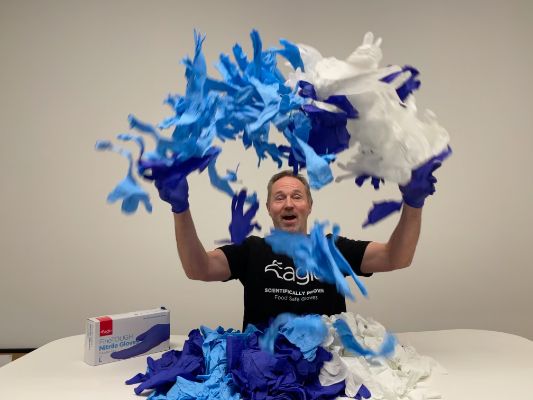Major Gap In Public Safety From Contaminated Gloves Identified: “Don’t Be Cheap,” Says Industry Veteran

Billions of protective gloves imported into the U.S. arrive with potential chemical and microbiological contaminant risks, without any inspection procedures, says a veteran glove supplier. These are the same gloves imported into New Zealand.
Speaking at the Food Safety Consortium conference in Parsippany, New Jersey, Eagle Protect founder Steve Ardagh said that the U.S. has a systemic problem with the management of glove imports. This issue was exacerbated during the pandemic, says Ardagh, with the U.S. flooded with cheap, unsafe, and contaminated gloves produced by sub-standard factories operated by fraudulent manufacturers and facilitated by racketeers, counterfeiters, and product dumpers.
“Food gloves are not required to be clean and intact or be tested on arrival for chemical or microbial contaminants. They are generally imported without the benefit of inspection on arrival into the U.S.,” says Ardagh. “This leaves millions of daily glove wearers and consumers exposed to the risk of illnesses, while businesses risk recalls,” says Ardagh.
Trillion Gloves from an Industry in Turmoil
It is estimated that a trillion gloves were used in the U.S. during the Covid-19 pandemic, of which over 90% were manufactured in 10 South Asian countries, with often largely unregulated and unmonitored manufacturing and quality assurance procedures.
“Currently, stockpiles of these low-quality gloves are being dumped into local markets with suspect expiry dates, no traceability, and no accountability,” says Ardagh.
The demands of the Pandemic exposed chronic gaps in U.S. glove importation regulations and procurement practices that Ardagh says need to be plugged to protect the public and wearers from contamination.
Each day it is estimated 328 million gloves are used across the U.S. by wearers in food processing and food service, medical and healthcare, law enforcement, industry, organics, and more recently, cannabis.
Glove toxins can contribute to a range of potential health issues including carcinogenicity, endocrine disruption, fertility impairment, metabolic disorders, and skin diseases including dermatitis.
Contaminated Water, Toxic Ingredients
Polluted water is attributed as the principal cause of microbial contamination, with cheap and often toxic ingredients weakening gloves leading to ripping. Ardagh’s company commissioned genomic testing for pathogens in 2,800 gloves from 26 imported brands and found faecal indicator organisms on 50 percent of gloves examined, along with 260 unique and viable microbes including E. coli, Listeria, Salmonella, Streptococcus, Staphylococcus, Anthrax, and various fungi including Aspergillus.
Protective gloves are meant to protect, not infect
Glove safety is critical in food processing and service to ensure gloves do not contaminate food. In a recent guidance, the FDA confirmed gloves as a Zone 1 Food Contact Surface – in direct contact with food and at the highest risk for product contamination.
“The economic impacts for the food industry include recalls, affected workers and customers, liability for outbreaks, lost productivity, and burdensome healthcare costs,” says Ardagh.
FDA Taking Action
Federal authorities have recently stepped up their action. As of September 2023, 228 medical glove manufacturers were placed on the FDA Import Alert for Disposable Examination Gloves for failure “to consistently provide medical gloves of adequate quality for distribution in the U.S. Defective medical gloves present a potential hazard to health for users as well as patients.” The highest number of companies listed are from China (136 companies), followed by Malaysia (42 companies), and Taiwan (25 companies).
Call for Procurement Standards, Improved Sourcing, Action on Verification
Speaker at the Food Safety Consortium conference Dr. Darin Detwiler, professor of food policy at Northeastern University, said there is one immediate way to address the glove contamination issue.
“Purchasers of protective gloves must insist on safe ingredients, bioburden testing standards, supply chain traceability, and the introduction of expiry dates.”
According to Dr. Detwiler, a food safety expert and participant in the new Netflix documentary Poisoned: The Dirty Truth About Your Food, corporate, business, and institutional purchasers of gloves should educate themselves about glove safety and make informed decisions about what to place on the hands of their employees.
“Glove contamination is a massive blind spot in public health, and it needs to be cleaned up, literally,” says Dr. Detwiler.
Eagle Protect’s Steve Ardagh says procurement practices usually focus on lowest cost. “Cheap does not mean safe,” says Ardagh. “It’s a case of ‘buyer beware.’ Don’t be cheap.”
The only Certified B Corp™ in the glove manufacturing business worldwide, Eagle Protect was founded in 2006, New Zealand. Also based in South Lake Tahoe, Eagle’s Delta Zero™ third-party testing program verifies that a range of Eagle gloves adhere to the highest level of consistent glove safety and performance. https://eagleprotect.co.nz/


 Emirates Team NZ: Statement From Emirates Team NZ On Auckland Hosting Of 38th America’s Cup
Emirates Team NZ: Statement From Emirates Team NZ On Auckland Hosting Of 38th America’s Cup PPTA Te Wehengarua: Draft English Curriculum Lacks Connection With Reality
PPTA Te Wehengarua: Draft English Curriculum Lacks Connection With Reality Oratia Books: Revised Edition Of Much-praised History Examines The Great War Experience Of New Zealand, Australia And Canada
Oratia Books: Revised Edition Of Much-praised History Examines The Great War Experience Of New Zealand, Australia And Canada Brain Injury NZ: Creating Solutions - ID Card For People With Brain Injury Launched
Brain Injury NZ: Creating Solutions - ID Card For People With Brain Injury Launched University of Auckland: AI Leads To Breakthrough In Knee Surgery
University of Auckland: AI Leads To Breakthrough In Knee Surgery The Label: Independent Music NZ Announces Taite Music Prize IMNZ Classic Record 2025
The Label: Independent Music NZ Announces Taite Music Prize IMNZ Classic Record 2025